A Case Study: Implementing COBIT 5 Framework for RFA IT Governance
VerifiedAdded on 2022/10/01
|48
|15835
|21
Report
AI Summary
This report presents a comprehensive case study on the Road Fund Administration (RFA), a public sector company, and its IT governance framework. The study focuses on the implementation of the COBIT 5 framework as a mechanism to address the limitations of the current IT governance structure, which is based on a five-year Integrated Strategic Business Plan, NAMCODE, and KING III. The research aims to analyze the effectiveness of the current framework, identify inadequacies, and evaluate the potential benefits of COBIT 5 implementation. The report explores the research questions, objectives, and rationale, including the advantages of COBIT 5 over other frameworks. The methodology includes a literature review, research methods, and data analysis. The findings highlight themes such as stakeholder needs, enterprise perspective, a single integrative framework, a holistic approach, and the separation of IT governance from general management. The conclusion provides recommendations for the RFA regarding the implementation of COBIT 5 to improve IT governance and achieve strategic goals, operational excellence, and risk management.
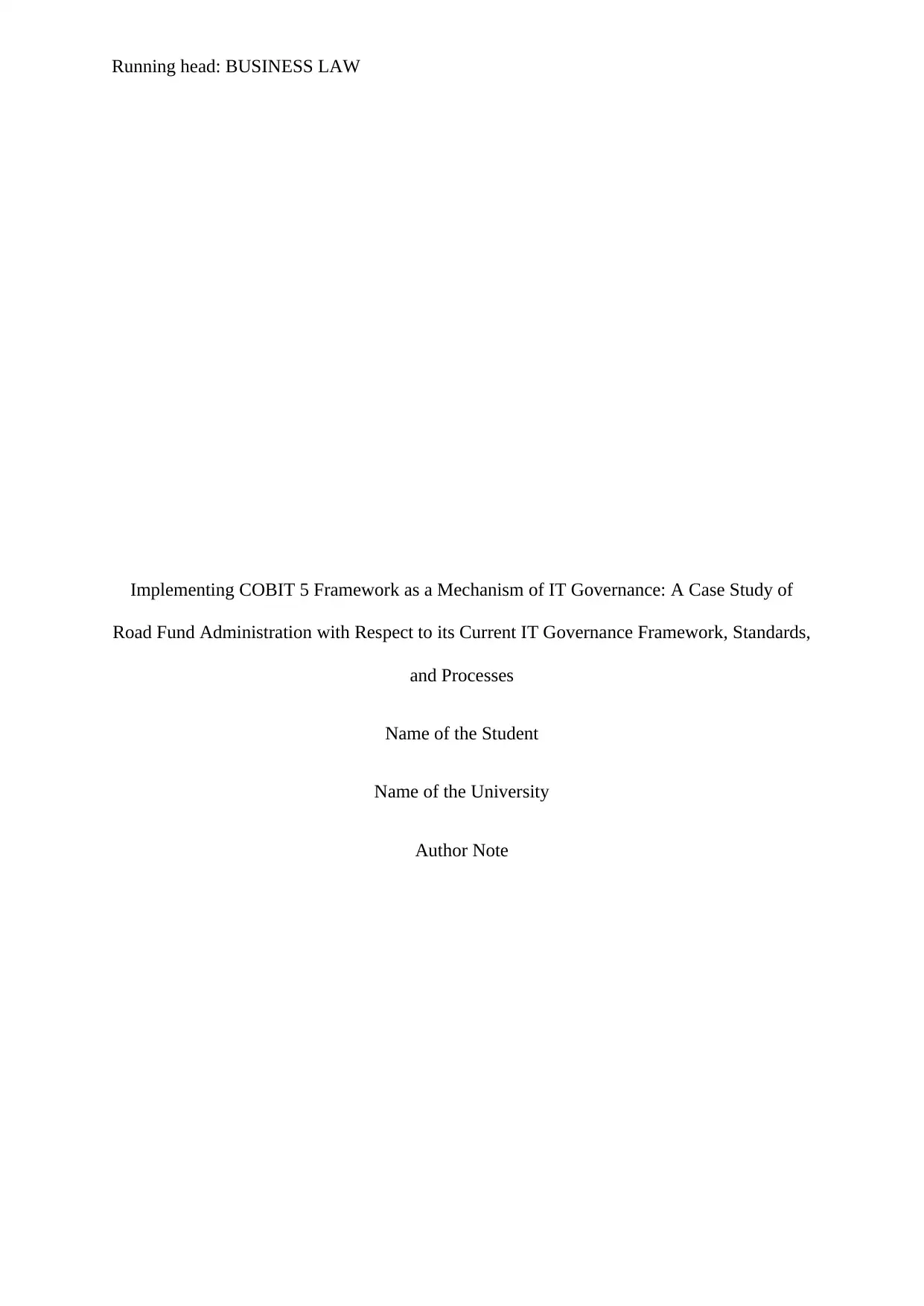
Running head: BUSINESS LAW
Implementing COBIT 5 Framework as a Mechanism of IT Governance: A Case Study of
Road Fund Administration with Respect to its Current IT Governance Framework, Standards,
and Processes
Name of the Student
Name of the University
Author Note
Implementing COBIT 5 Framework as a Mechanism of IT Governance: A Case Study of
Road Fund Administration with Respect to its Current IT Governance Framework, Standards,
and Processes
Name of the Student
Name of the University
Author Note
Paraphrase This Document
Need a fresh take? Get an instant paraphrase of this document with our AI Paraphraser
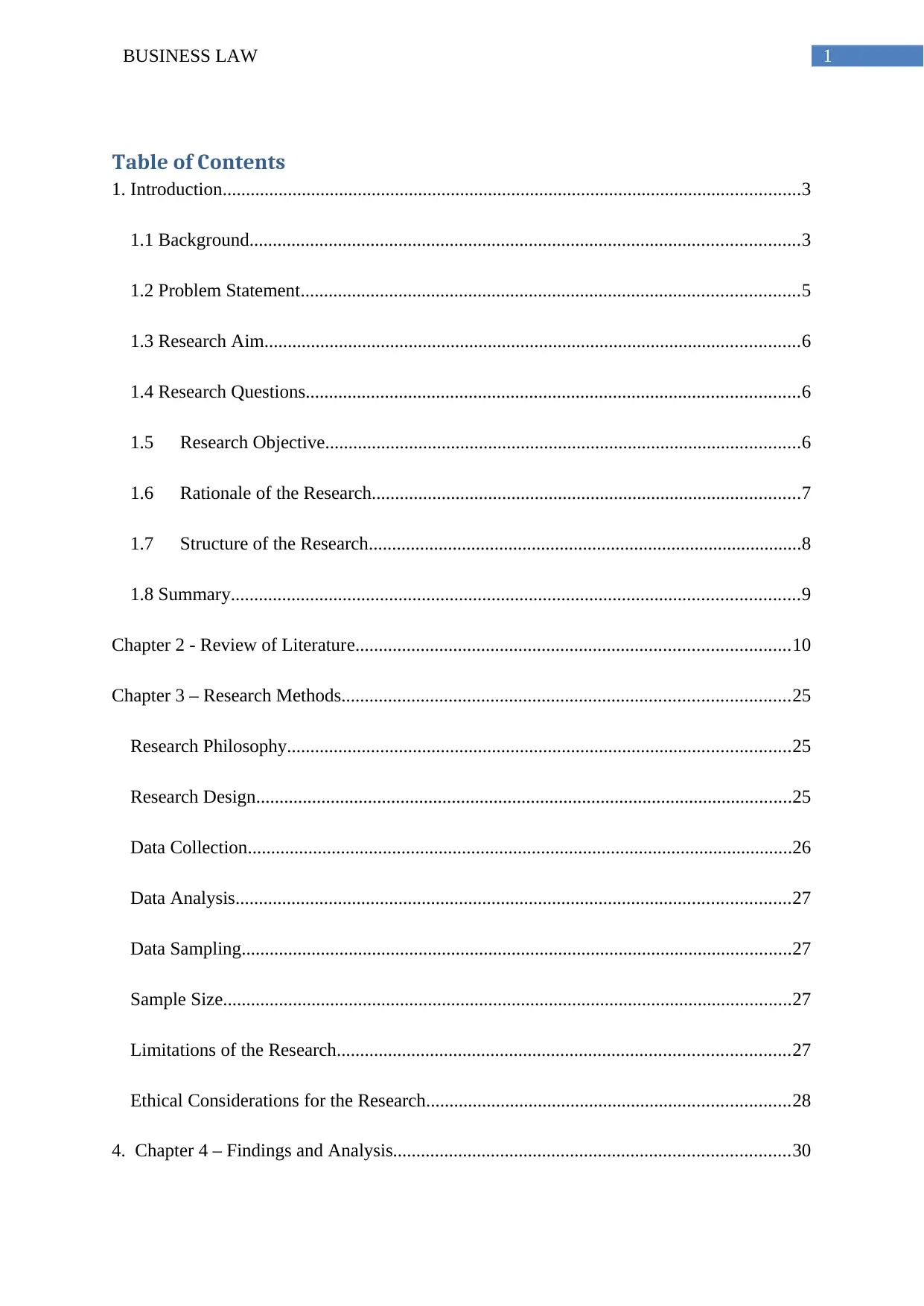
1BUSINESS LAW
Table of Contents
1. Introduction............................................................................................................................3
1.1 Background......................................................................................................................3
1.2 Problem Statement...........................................................................................................5
1.3 Research Aim...................................................................................................................6
1.4 Research Questions..........................................................................................................6
1.5 Research Objective......................................................................................................6
1.6 Rationale of the Research............................................................................................7
1.7 Structure of the Research.............................................................................................8
1.8 Summary..........................................................................................................................9
Chapter 2 - Review of Literature.............................................................................................10
Chapter 3 – Research Methods................................................................................................25
Research Philosophy............................................................................................................25
Research Design...................................................................................................................25
Data Collection.....................................................................................................................26
Data Analysis.......................................................................................................................27
Data Sampling......................................................................................................................27
Sample Size..........................................................................................................................27
Limitations of the Research.................................................................................................27
Ethical Considerations for the Research..............................................................................28
4. Chapter 4 – Findings and Analysis.....................................................................................30
Table of Contents
1. Introduction............................................................................................................................3
1.1 Background......................................................................................................................3
1.2 Problem Statement...........................................................................................................5
1.3 Research Aim...................................................................................................................6
1.4 Research Questions..........................................................................................................6
1.5 Research Objective......................................................................................................6
1.6 Rationale of the Research............................................................................................7
1.7 Structure of the Research.............................................................................................8
1.8 Summary..........................................................................................................................9
Chapter 2 - Review of Literature.............................................................................................10
Chapter 3 – Research Methods................................................................................................25
Research Philosophy............................................................................................................25
Research Design...................................................................................................................25
Data Collection.....................................................................................................................26
Data Analysis.......................................................................................................................27
Data Sampling......................................................................................................................27
Sample Size..........................................................................................................................27
Limitations of the Research.................................................................................................27
Ethical Considerations for the Research..............................................................................28
4. Chapter 4 – Findings and Analysis.....................................................................................30
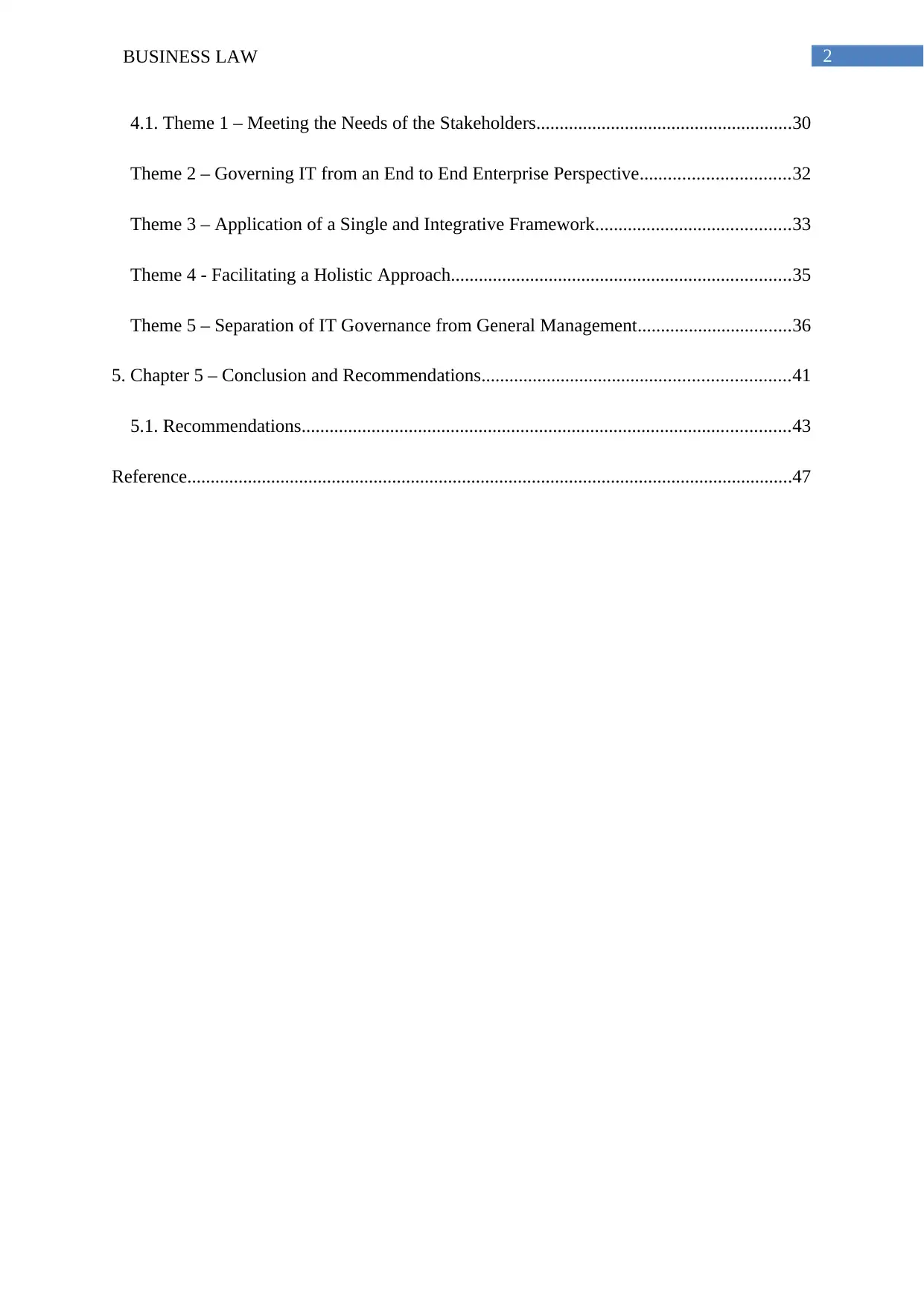
2BUSINESS LAW
4.1. Theme 1 – Meeting the Needs of the Stakeholders.......................................................30
Theme 2 – Governing IT from an End to End Enterprise Perspective................................32
Theme 3 – Application of a Single and Integrative Framework..........................................33
Theme 4 - Facilitating a Holistic Approach.........................................................................35
Theme 5 – Separation of IT Governance from General Management.................................36
5. Chapter 5 – Conclusion and Recommendations..................................................................41
5.1. Recommendations.........................................................................................................43
Reference..................................................................................................................................47
4.1. Theme 1 – Meeting the Needs of the Stakeholders.......................................................30
Theme 2 – Governing IT from an End to End Enterprise Perspective................................32
Theme 3 – Application of a Single and Integrative Framework..........................................33
Theme 4 - Facilitating a Holistic Approach.........................................................................35
Theme 5 – Separation of IT Governance from General Management.................................36
5. Chapter 5 – Conclusion and Recommendations..................................................................41
5.1. Recommendations.........................................................................................................43
Reference..................................................................................................................................47
⊘ This is a preview!⊘
Do you want full access?
Subscribe today to unlock all pages.

Trusted by 1+ million students worldwide
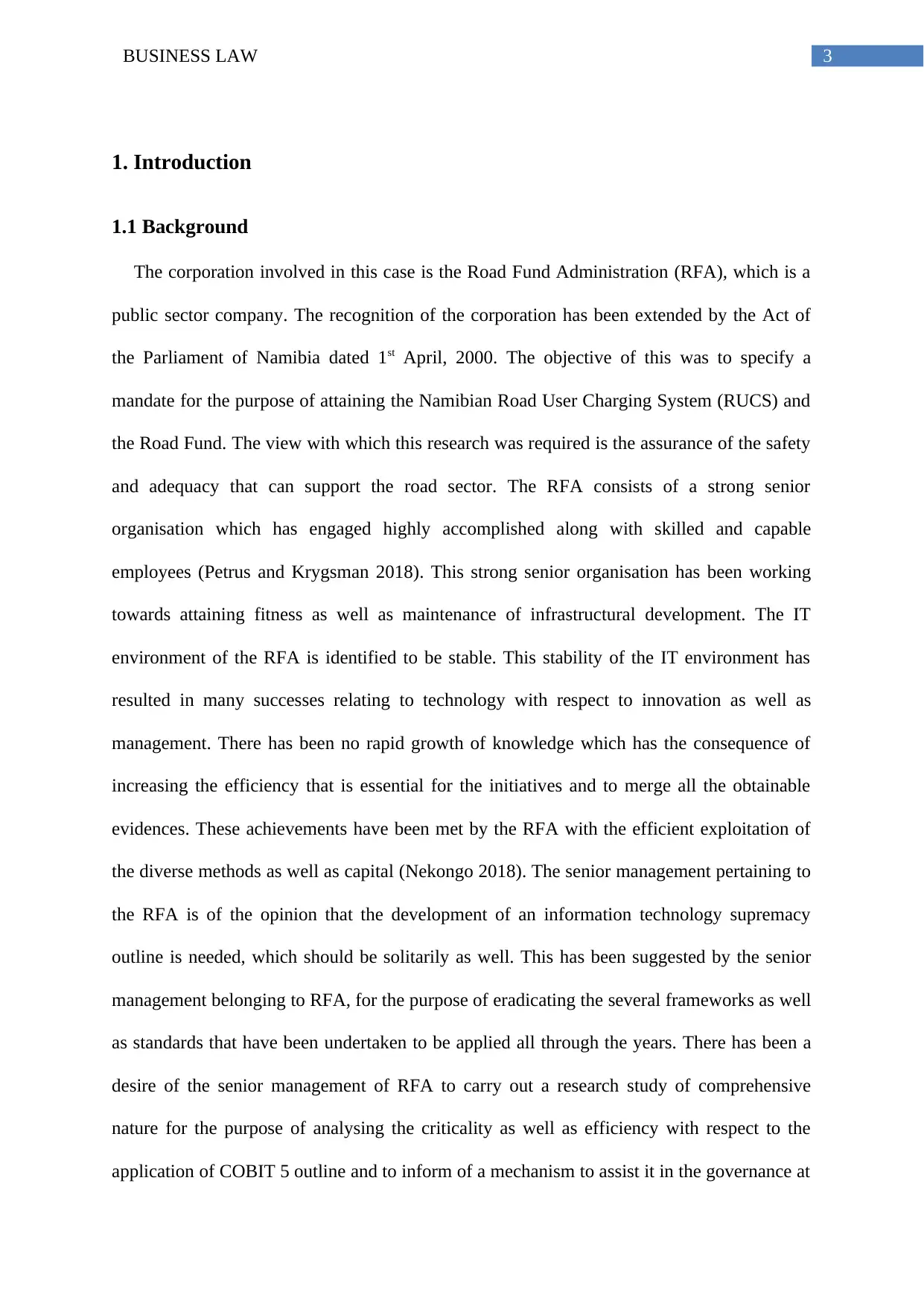
3BUSINESS LAW
1. Introduction
1.1 Background
The corporation involved in this case is the Road Fund Administration (RFA), which is a
public sector company. The recognition of the corporation has been extended by the Act of
the Parliament of Namibia dated 1st April, 2000. The objective of this was to specify a
mandate for the purpose of attaining the Namibian Road User Charging System (RUCS) and
the Road Fund. The view with which this research was required is the assurance of the safety
and adequacy that can support the road sector. The RFA consists of a strong senior
organisation which has engaged highly accomplished along with skilled and capable
employees (Petrus and Krygsman 2018). This strong senior organisation has been working
towards attaining fitness as well as maintenance of infrastructural development. The IT
environment of the RFA is identified to be stable. This stability of the IT environment has
resulted in many successes relating to technology with respect to innovation as well as
management. There has been no rapid growth of knowledge which has the consequence of
increasing the efficiency that is essential for the initiatives and to merge all the obtainable
evidences. These achievements have been met by the RFA with the efficient exploitation of
the diverse methods as well as capital (Nekongo 2018). The senior management pertaining to
the RFA is of the opinion that the development of an information technology supremacy
outline is needed, which should be solitarily as well. This has been suggested by the senior
management belonging to RFA, for the purpose of eradicating the several frameworks as well
as standards that have been undertaken to be applied all through the years. There has been a
desire of the senior management of RFA to carry out a research study of comprehensive
nature for the purpose of analysing the criticality as well as efficiency with respect to the
application of COBIT 5 outline and to inform of a mechanism to assist it in the governance at
1. Introduction
1.1 Background
The corporation involved in this case is the Road Fund Administration (RFA), which is a
public sector company. The recognition of the corporation has been extended by the Act of
the Parliament of Namibia dated 1st April, 2000. The objective of this was to specify a
mandate for the purpose of attaining the Namibian Road User Charging System (RUCS) and
the Road Fund. The view with which this research was required is the assurance of the safety
and adequacy that can support the road sector. The RFA consists of a strong senior
organisation which has engaged highly accomplished along with skilled and capable
employees (Petrus and Krygsman 2018). This strong senior organisation has been working
towards attaining fitness as well as maintenance of infrastructural development. The IT
environment of the RFA is identified to be stable. This stability of the IT environment has
resulted in many successes relating to technology with respect to innovation as well as
management. There has been no rapid growth of knowledge which has the consequence of
increasing the efficiency that is essential for the initiatives and to merge all the obtainable
evidences. These achievements have been met by the RFA with the efficient exploitation of
the diverse methods as well as capital (Nekongo 2018). The senior management pertaining to
the RFA is of the opinion that the development of an information technology supremacy
outline is needed, which should be solitarily as well. This has been suggested by the senior
management belonging to RFA, for the purpose of eradicating the several frameworks as well
as standards that have been undertaken to be applied all through the years. There has been a
desire of the senior management of RFA to carry out a research study of comprehensive
nature for the purpose of analysing the criticality as well as efficiency with respect to the
application of COBIT 5 outline and to inform of a mechanism to assist it in the governance at
Paraphrase This Document
Need a fresh take? Get an instant paraphrase of this document with our AI Paraphraser
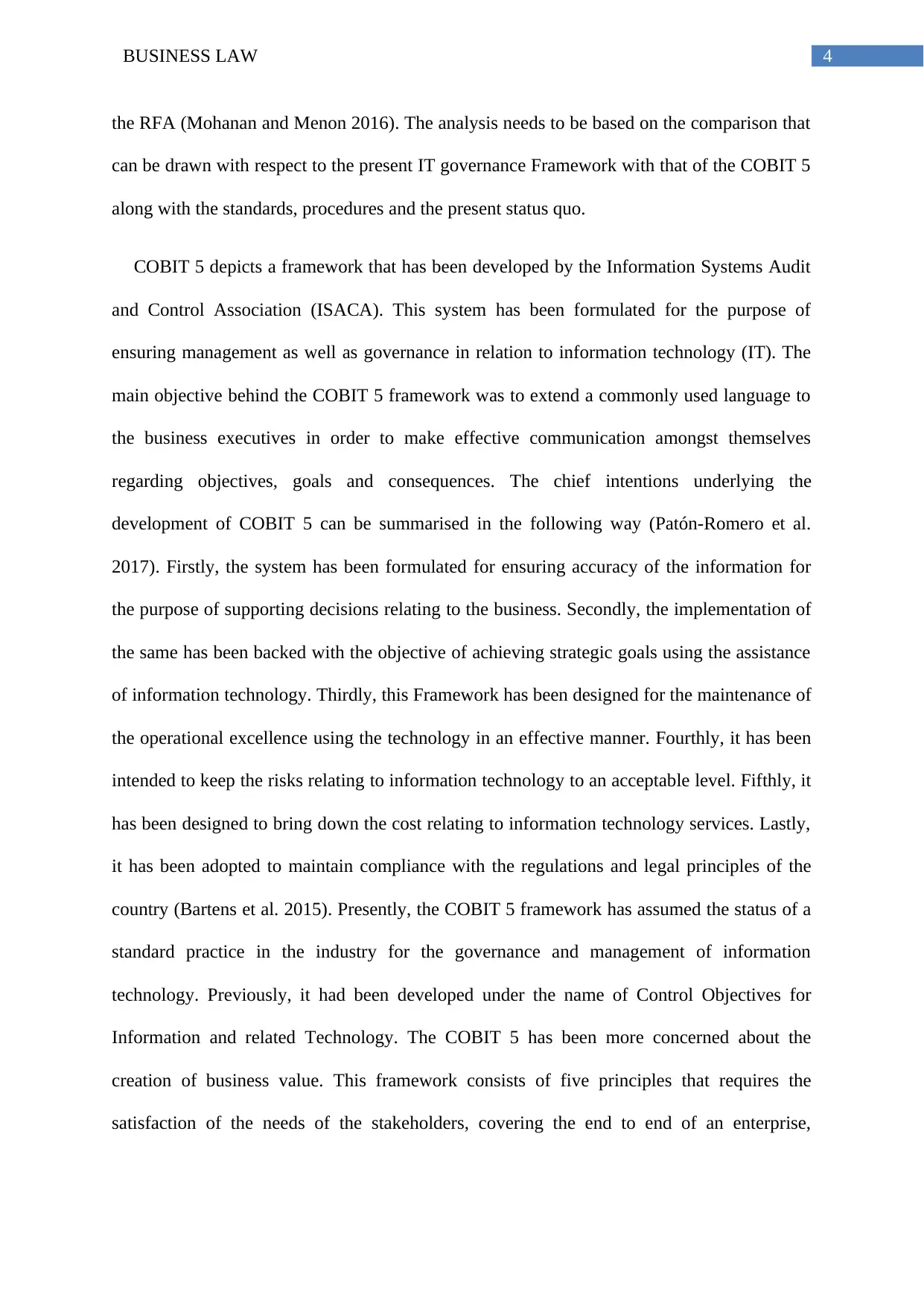
4BUSINESS LAW
the RFA (Mohanan and Menon 2016). The analysis needs to be based on the comparison that
can be drawn with respect to the present IT governance Framework with that of the COBIT 5
along with the standards, procedures and the present status quo.
COBIT 5 depicts a framework that has been developed by the Information Systems Audit
and Control Association (ISACA). This system has been formulated for the purpose of
ensuring management as well as governance in relation to information technology (IT). The
main objective behind the COBIT 5 framework was to extend a commonly used language to
the business executives in order to make effective communication amongst themselves
regarding objectives, goals and consequences. The chief intentions underlying the
development of COBIT 5 can be summarised in the following way (Patón-Romero et al.
2017). Firstly, the system has been formulated for ensuring accuracy of the information for
the purpose of supporting decisions relating to the business. Secondly, the implementation of
the same has been backed with the objective of achieving strategic goals using the assistance
of information technology. Thirdly, this Framework has been designed for the maintenance of
the operational excellence using the technology in an effective manner. Fourthly, it has been
intended to keep the risks relating to information technology to an acceptable level. Fifthly, it
has been designed to bring down the cost relating to information technology services. Lastly,
it has been adopted to maintain compliance with the regulations and legal principles of the
country (Bartens et al. 2015). Presently, the COBIT 5 framework has assumed the status of a
standard practice in the industry for the governance and management of information
technology. Previously, it had been developed under the name of Control Objectives for
Information and related Technology. The COBIT 5 has been more concerned about the
creation of business value. This framework consists of five principles that requires the
satisfaction of the needs of the stakeholders, covering the end to end of an enterprise,
the RFA (Mohanan and Menon 2016). The analysis needs to be based on the comparison that
can be drawn with respect to the present IT governance Framework with that of the COBIT 5
along with the standards, procedures and the present status quo.
COBIT 5 depicts a framework that has been developed by the Information Systems Audit
and Control Association (ISACA). This system has been formulated for the purpose of
ensuring management as well as governance in relation to information technology (IT). The
main objective behind the COBIT 5 framework was to extend a commonly used language to
the business executives in order to make effective communication amongst themselves
regarding objectives, goals and consequences. The chief intentions underlying the
development of COBIT 5 can be summarised in the following way (Patón-Romero et al.
2017). Firstly, the system has been formulated for ensuring accuracy of the information for
the purpose of supporting decisions relating to the business. Secondly, the implementation of
the same has been backed with the objective of achieving strategic goals using the assistance
of information technology. Thirdly, this Framework has been designed for the maintenance of
the operational excellence using the technology in an effective manner. Fourthly, it has been
intended to keep the risks relating to information technology to an acceptable level. Fifthly, it
has been designed to bring down the cost relating to information technology services. Lastly,
it has been adopted to maintain compliance with the regulations and legal principles of the
country (Bartens et al. 2015). Presently, the COBIT 5 framework has assumed the status of a
standard practice in the industry for the governance and management of information
technology. Previously, it had been developed under the name of Control Objectives for
Information and related Technology. The COBIT 5 has been more concerned about the
creation of business value. This framework consists of five principles that requires the
satisfaction of the needs of the stakeholders, covering the end to end of an enterprise,
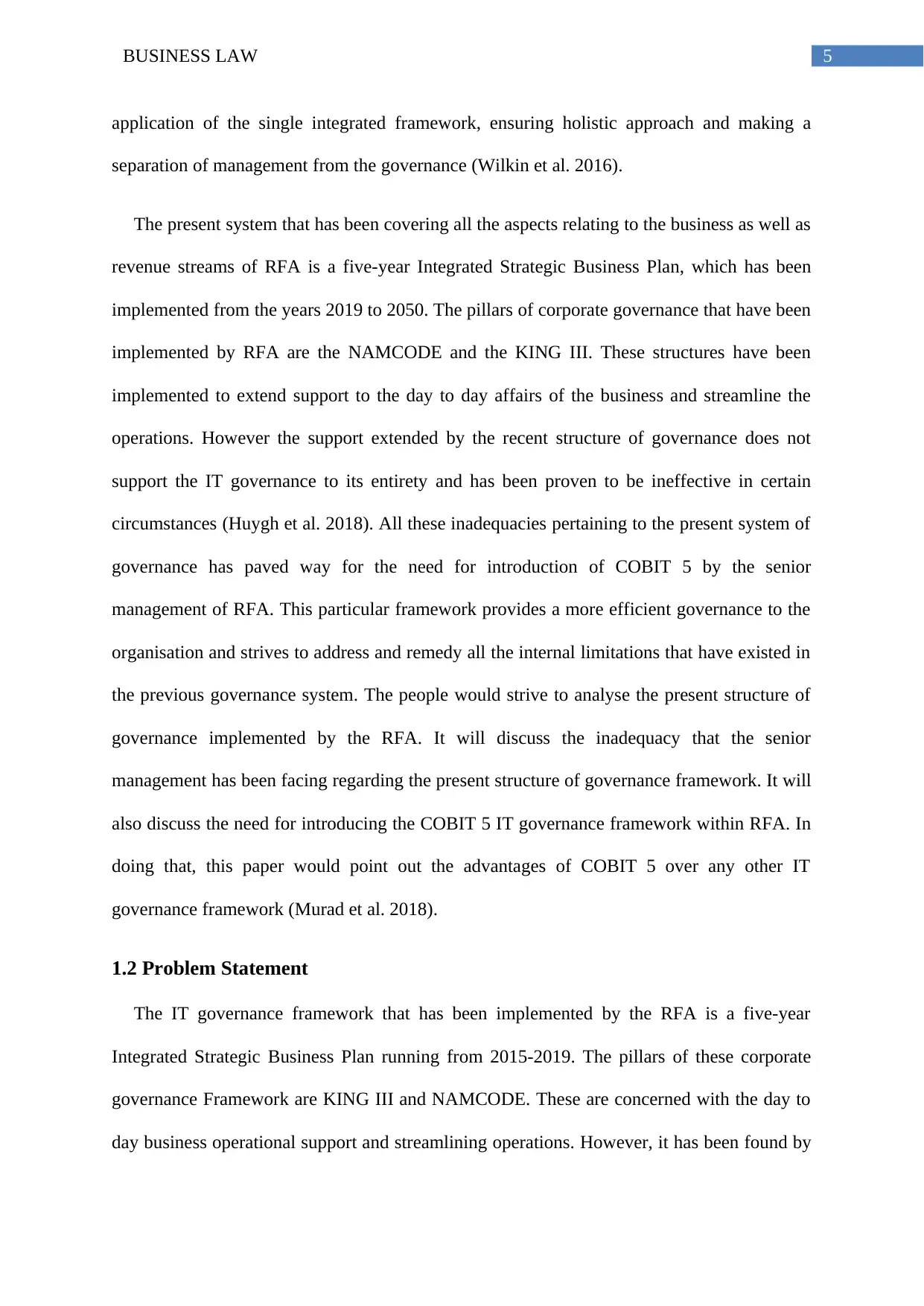
5BUSINESS LAW
application of the single integrated framework, ensuring holistic approach and making a
separation of management from the governance (Wilkin et al. 2016).
The present system that has been covering all the aspects relating to the business as well as
revenue streams of RFA is a five-year Integrated Strategic Business Plan, which has been
implemented from the years 2019 to 2050. The pillars of corporate governance that have been
implemented by RFA are the NAMCODE and the KING III. These structures have been
implemented to extend support to the day to day affairs of the business and streamline the
operations. However the support extended by the recent structure of governance does not
support the IT governance to its entirety and has been proven to be ineffective in certain
circumstances (Huygh et al. 2018). All these inadequacies pertaining to the present system of
governance has paved way for the need for introduction of COBIT 5 by the senior
management of RFA. This particular framework provides a more efficient governance to the
organisation and strives to address and remedy all the internal limitations that have existed in
the previous governance system. The people would strive to analyse the present structure of
governance implemented by the RFA. It will discuss the inadequacy that the senior
management has been facing regarding the present structure of governance framework. It will
also discuss the need for introducing the COBIT 5 IT governance framework within RFA. In
doing that, this paper would point out the advantages of COBIT 5 over any other IT
governance framework (Murad et al. 2018).
1.2 Problem Statement
The IT governance framework that has been implemented by the RFA is a five-year
Integrated Strategic Business Plan running from 2015-2019. The pillars of these corporate
governance Framework are KING III and NAMCODE. These are concerned with the day to
day business operational support and streamlining operations. However, it has been found by
application of the single integrated framework, ensuring holistic approach and making a
separation of management from the governance (Wilkin et al. 2016).
The present system that has been covering all the aspects relating to the business as well as
revenue streams of RFA is a five-year Integrated Strategic Business Plan, which has been
implemented from the years 2019 to 2050. The pillars of corporate governance that have been
implemented by RFA are the NAMCODE and the KING III. These structures have been
implemented to extend support to the day to day affairs of the business and streamline the
operations. However the support extended by the recent structure of governance does not
support the IT governance to its entirety and has been proven to be ineffective in certain
circumstances (Huygh et al. 2018). All these inadequacies pertaining to the present system of
governance has paved way for the need for introduction of COBIT 5 by the senior
management of RFA. This particular framework provides a more efficient governance to the
organisation and strives to address and remedy all the internal limitations that have existed in
the previous governance system. The people would strive to analyse the present structure of
governance implemented by the RFA. It will discuss the inadequacy that the senior
management has been facing regarding the present structure of governance framework. It will
also discuss the need for introducing the COBIT 5 IT governance framework within RFA. In
doing that, this paper would point out the advantages of COBIT 5 over any other IT
governance framework (Murad et al. 2018).
1.2 Problem Statement
The IT governance framework that has been implemented by the RFA is a five-year
Integrated Strategic Business Plan running from 2015-2019. The pillars of these corporate
governance Framework are KING III and NAMCODE. These are concerned with the day to
day business operational support and streamlining operations. However, it has been found by
⊘ This is a preview!⊘
Do you want full access?
Subscribe today to unlock all pages.

Trusted by 1+ million students worldwide
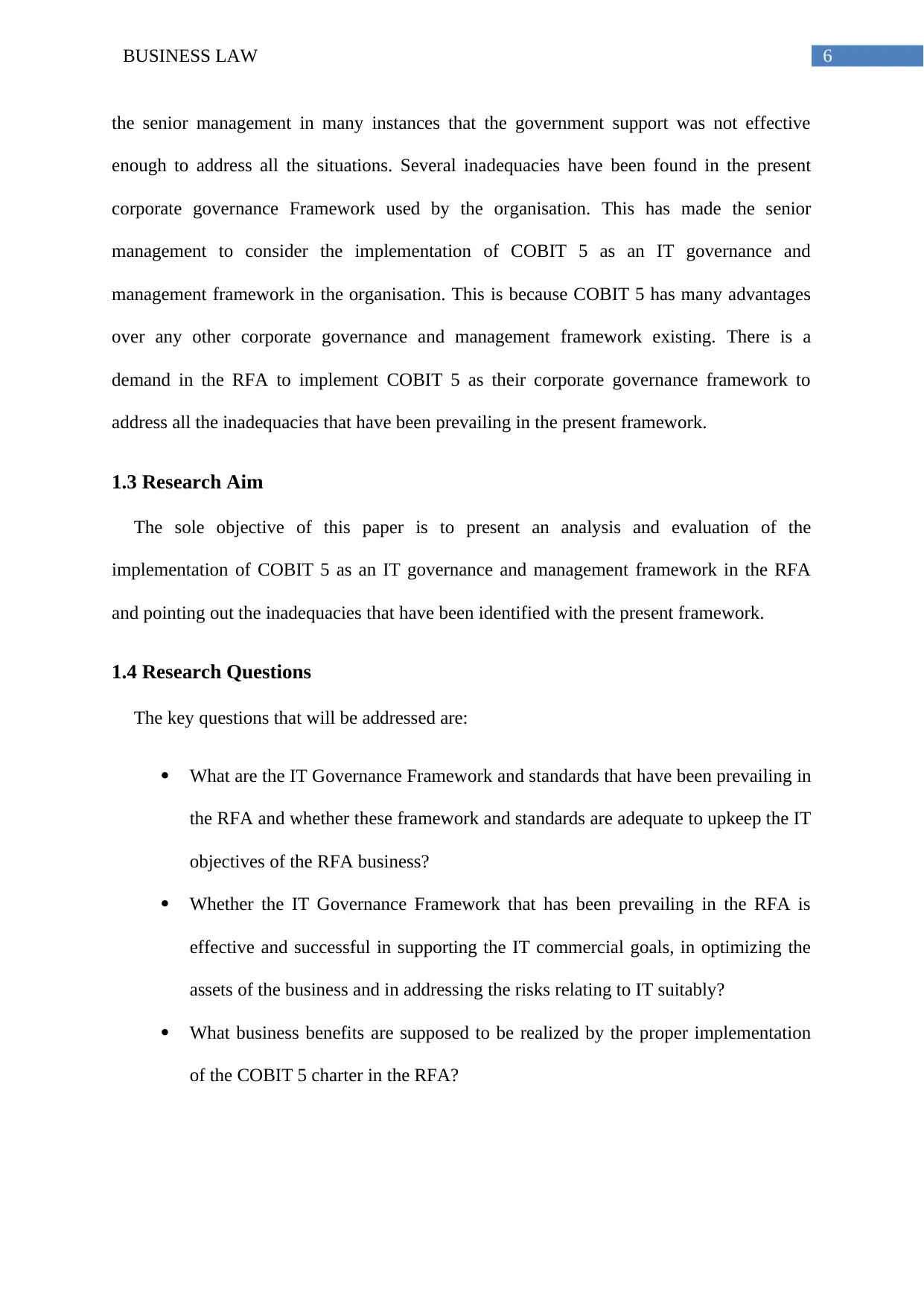
6BUSINESS LAW
the senior management in many instances that the government support was not effective
enough to address all the situations. Several inadequacies have been found in the present
corporate governance Framework used by the organisation. This has made the senior
management to consider the implementation of COBIT 5 as an IT governance and
management framework in the organisation. This is because COBIT 5 has many advantages
over any other corporate governance and management framework existing. There is a
demand in the RFA to implement COBIT 5 as their corporate governance framework to
address all the inadequacies that have been prevailing in the present framework.
1.3 Research Aim
The sole objective of this paper is to present an analysis and evaluation of the
implementation of COBIT 5 as an IT governance and management framework in the RFA
and pointing out the inadequacies that have been identified with the present framework.
1.4 Research Questions
The key questions that will be addressed are:
What are the IT Governance Framework and standards that have been prevailing in
the RFA and whether these framework and standards are adequate to upkeep the IT
objectives of the RFA business?
Whether the IT Governance Framework that has been prevailing in the RFA is
effective and successful in supporting the IT commercial goals, in optimizing the
assets of the business and in addressing the risks relating to IT suitably?
What business benefits are supposed to be realized by the proper implementation
of the COBIT 5 charter in the RFA?
the senior management in many instances that the government support was not effective
enough to address all the situations. Several inadequacies have been found in the present
corporate governance Framework used by the organisation. This has made the senior
management to consider the implementation of COBIT 5 as an IT governance and
management framework in the organisation. This is because COBIT 5 has many advantages
over any other corporate governance and management framework existing. There is a
demand in the RFA to implement COBIT 5 as their corporate governance framework to
address all the inadequacies that have been prevailing in the present framework.
1.3 Research Aim
The sole objective of this paper is to present an analysis and evaluation of the
implementation of COBIT 5 as an IT governance and management framework in the RFA
and pointing out the inadequacies that have been identified with the present framework.
1.4 Research Questions
The key questions that will be addressed are:
What are the IT Governance Framework and standards that have been prevailing in
the RFA and whether these framework and standards are adequate to upkeep the IT
objectives of the RFA business?
Whether the IT Governance Framework that has been prevailing in the RFA is
effective and successful in supporting the IT commercial goals, in optimizing the
assets of the business and in addressing the risks relating to IT suitably?
What business benefits are supposed to be realized by the proper implementation
of the COBIT 5 charter in the RFA?
Paraphrase This Document
Need a fresh take? Get an instant paraphrase of this document with our AI Paraphraser
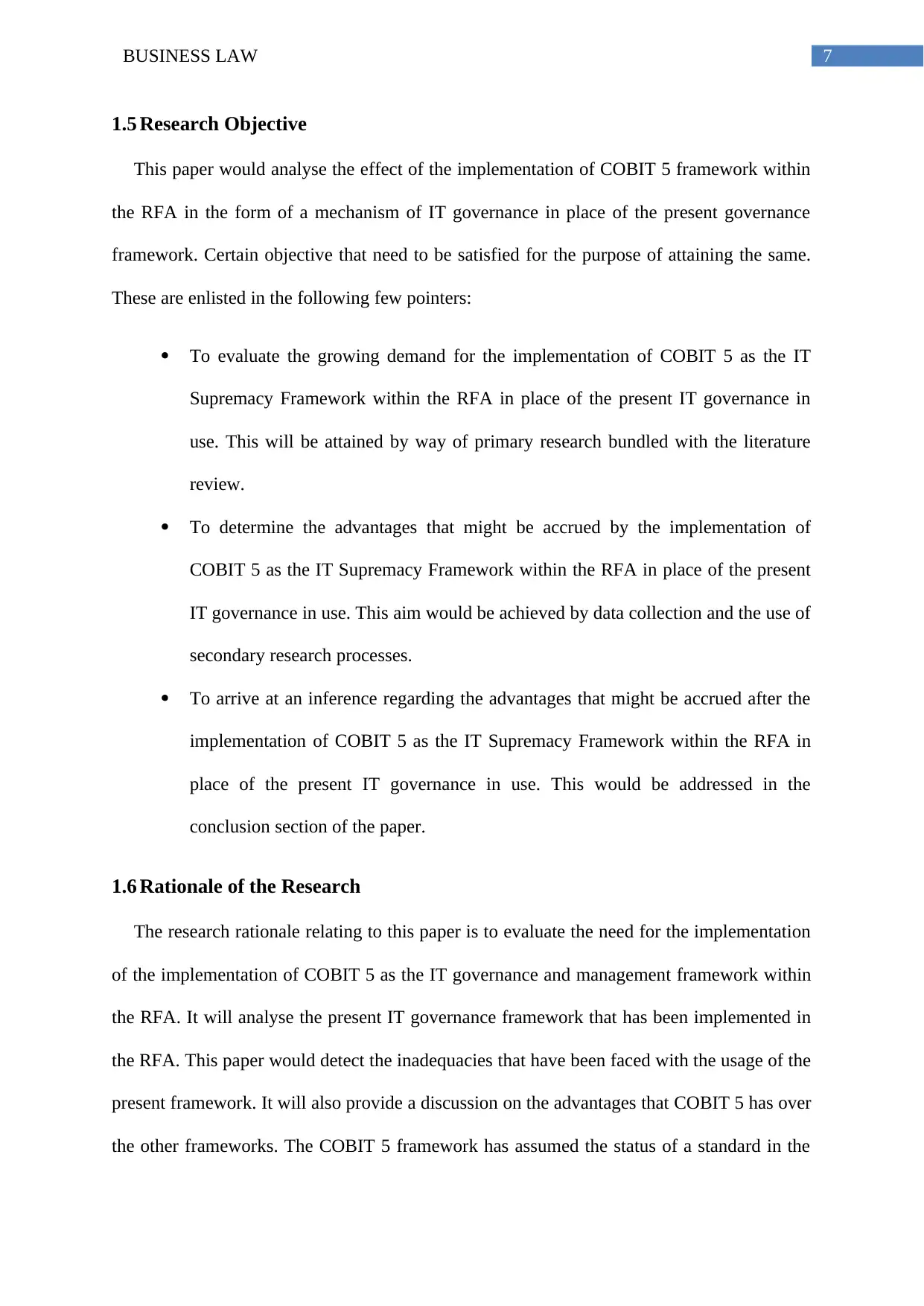
7BUSINESS LAW
1.5 Research Objective
This paper would analyse the effect of the implementation of COBIT 5 framework within
the RFA in the form of a mechanism of IT governance in place of the present governance
framework. Certain objective that need to be satisfied for the purpose of attaining the same.
These are enlisted in the following few pointers:
To evaluate the growing demand for the implementation of COBIT 5 as the IT
Supremacy Framework within the RFA in place of the present IT governance in
use. This will be attained by way of primary research bundled with the literature
review.
To determine the advantages that might be accrued by the implementation of
COBIT 5 as the IT Supremacy Framework within the RFA in place of the present
IT governance in use. This aim would be achieved by data collection and the use of
secondary research processes.
To arrive at an inference regarding the advantages that might be accrued after the
implementation of COBIT 5 as the IT Supremacy Framework within the RFA in
place of the present IT governance in use. This would be addressed in the
conclusion section of the paper.
1.6 Rationale of the Research
The research rationale relating to this paper is to evaluate the need for the implementation
of the implementation of COBIT 5 as the IT governance and management framework within
the RFA. It will analyse the present IT governance framework that has been implemented in
the RFA. This paper would detect the inadequacies that have been faced with the usage of the
present framework. It will also provide a discussion on the advantages that COBIT 5 has over
the other frameworks. The COBIT 5 framework has assumed the status of a standard in the
1.5 Research Objective
This paper would analyse the effect of the implementation of COBIT 5 framework within
the RFA in the form of a mechanism of IT governance in place of the present governance
framework. Certain objective that need to be satisfied for the purpose of attaining the same.
These are enlisted in the following few pointers:
To evaluate the growing demand for the implementation of COBIT 5 as the IT
Supremacy Framework within the RFA in place of the present IT governance in
use. This will be attained by way of primary research bundled with the literature
review.
To determine the advantages that might be accrued by the implementation of
COBIT 5 as the IT Supremacy Framework within the RFA in place of the present
IT governance in use. This aim would be achieved by data collection and the use of
secondary research processes.
To arrive at an inference regarding the advantages that might be accrued after the
implementation of COBIT 5 as the IT Supremacy Framework within the RFA in
place of the present IT governance in use. This would be addressed in the
conclusion section of the paper.
1.6 Rationale of the Research
The research rationale relating to this paper is to evaluate the need for the implementation
of the implementation of COBIT 5 as the IT governance and management framework within
the RFA. It will analyse the present IT governance framework that has been implemented in
the RFA. This paper would detect the inadequacies that have been faced with the usage of the
present framework. It will also provide a discussion on the advantages that COBIT 5 has over
the other frameworks. The COBIT 5 framework has assumed the status of a standard in the
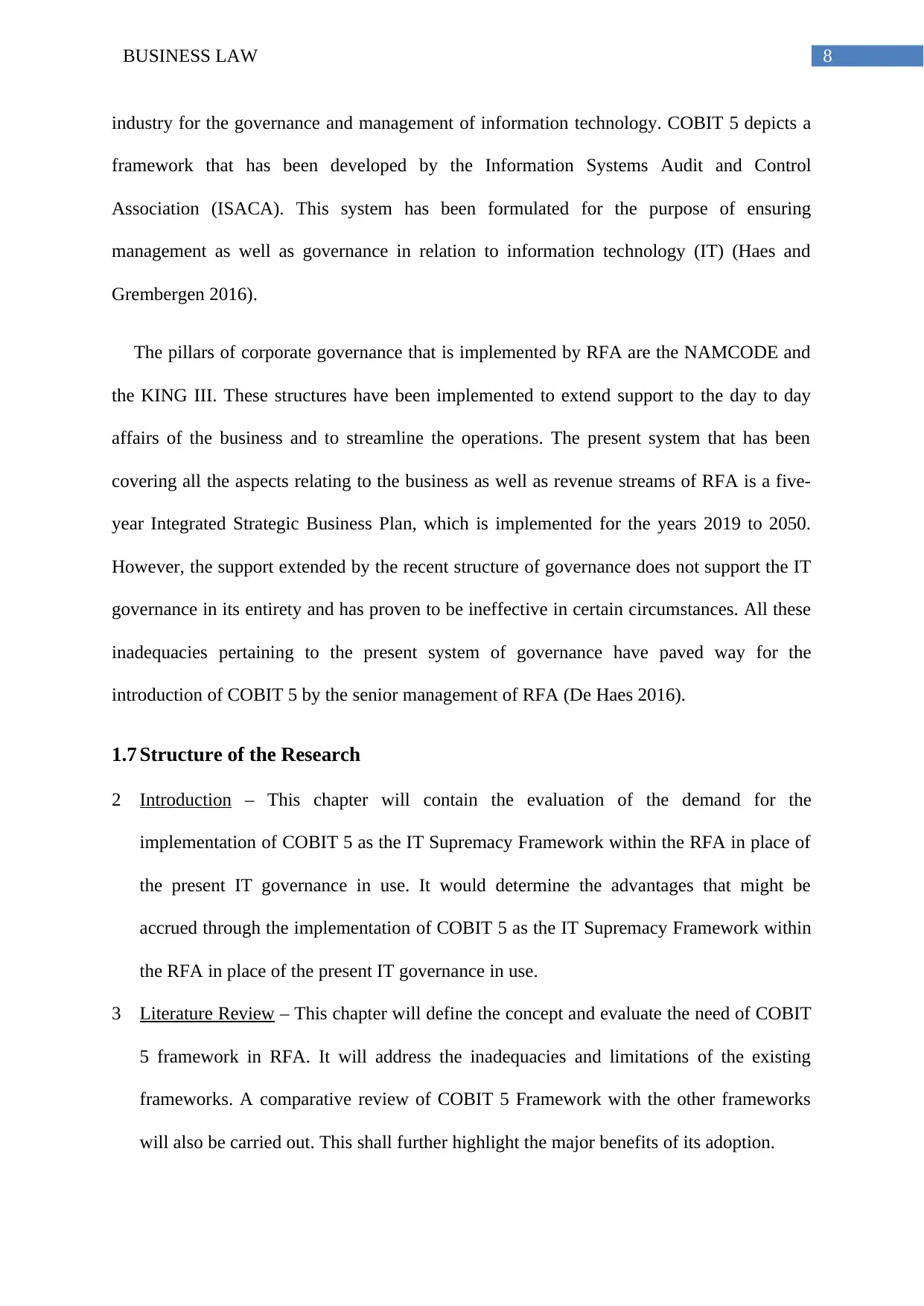
8BUSINESS LAW
industry for the governance and management of information technology. COBIT 5 depicts a
framework that has been developed by the Information Systems Audit and Control
Association (ISACA). This system has been formulated for the purpose of ensuring
management as well as governance in relation to information technology (IT) (Haes and
Grembergen 2016).
The pillars of corporate governance that is implemented by RFA are the NAMCODE and
the KING III. These structures have been implemented to extend support to the day to day
affairs of the business and to streamline the operations. The present system that has been
covering all the aspects relating to the business as well as revenue streams of RFA is a five-
year Integrated Strategic Business Plan, which is implemented for the years 2019 to 2050.
However, the support extended by the recent structure of governance does not support the IT
governance in its entirety and has proven to be ineffective in certain circumstances. All these
inadequacies pertaining to the present system of governance have paved way for the
introduction of COBIT 5 by the senior management of RFA (De Haes 2016).
1.7 Structure of the Research
2 Introduction – This chapter will contain the evaluation of the demand for the
implementation of COBIT 5 as the IT Supremacy Framework within the RFA in place of
the present IT governance in use. It would determine the advantages that might be
accrued through the implementation of COBIT 5 as the IT Supremacy Framework within
the RFA in place of the present IT governance in use.
3 Literature Review – This chapter will define the concept and evaluate the need of COBIT
5 framework in RFA. It will address the inadequacies and limitations of the existing
frameworks. A comparative review of COBIT 5 Framework with the other frameworks
will also be carried out. This shall further highlight the major benefits of its adoption.
industry for the governance and management of information technology. COBIT 5 depicts a
framework that has been developed by the Information Systems Audit and Control
Association (ISACA). This system has been formulated for the purpose of ensuring
management as well as governance in relation to information technology (IT) (Haes and
Grembergen 2016).
The pillars of corporate governance that is implemented by RFA are the NAMCODE and
the KING III. These structures have been implemented to extend support to the day to day
affairs of the business and to streamline the operations. The present system that has been
covering all the aspects relating to the business as well as revenue streams of RFA is a five-
year Integrated Strategic Business Plan, which is implemented for the years 2019 to 2050.
However, the support extended by the recent structure of governance does not support the IT
governance in its entirety and has proven to be ineffective in certain circumstances. All these
inadequacies pertaining to the present system of governance have paved way for the
introduction of COBIT 5 by the senior management of RFA (De Haes 2016).
1.7 Structure of the Research
2 Introduction – This chapter will contain the evaluation of the demand for the
implementation of COBIT 5 as the IT Supremacy Framework within the RFA in place of
the present IT governance in use. It would determine the advantages that might be
accrued through the implementation of COBIT 5 as the IT Supremacy Framework within
the RFA in place of the present IT governance in use.
3 Literature Review – This chapter will define the concept and evaluate the need of COBIT
5 framework in RFA. It will address the inadequacies and limitations of the existing
frameworks. A comparative review of COBIT 5 Framework with the other frameworks
will also be carried out. This shall further highlight the major benefits of its adoption.
⊘ This is a preview!⊘
Do you want full access?
Subscribe today to unlock all pages.

Trusted by 1+ million students worldwide
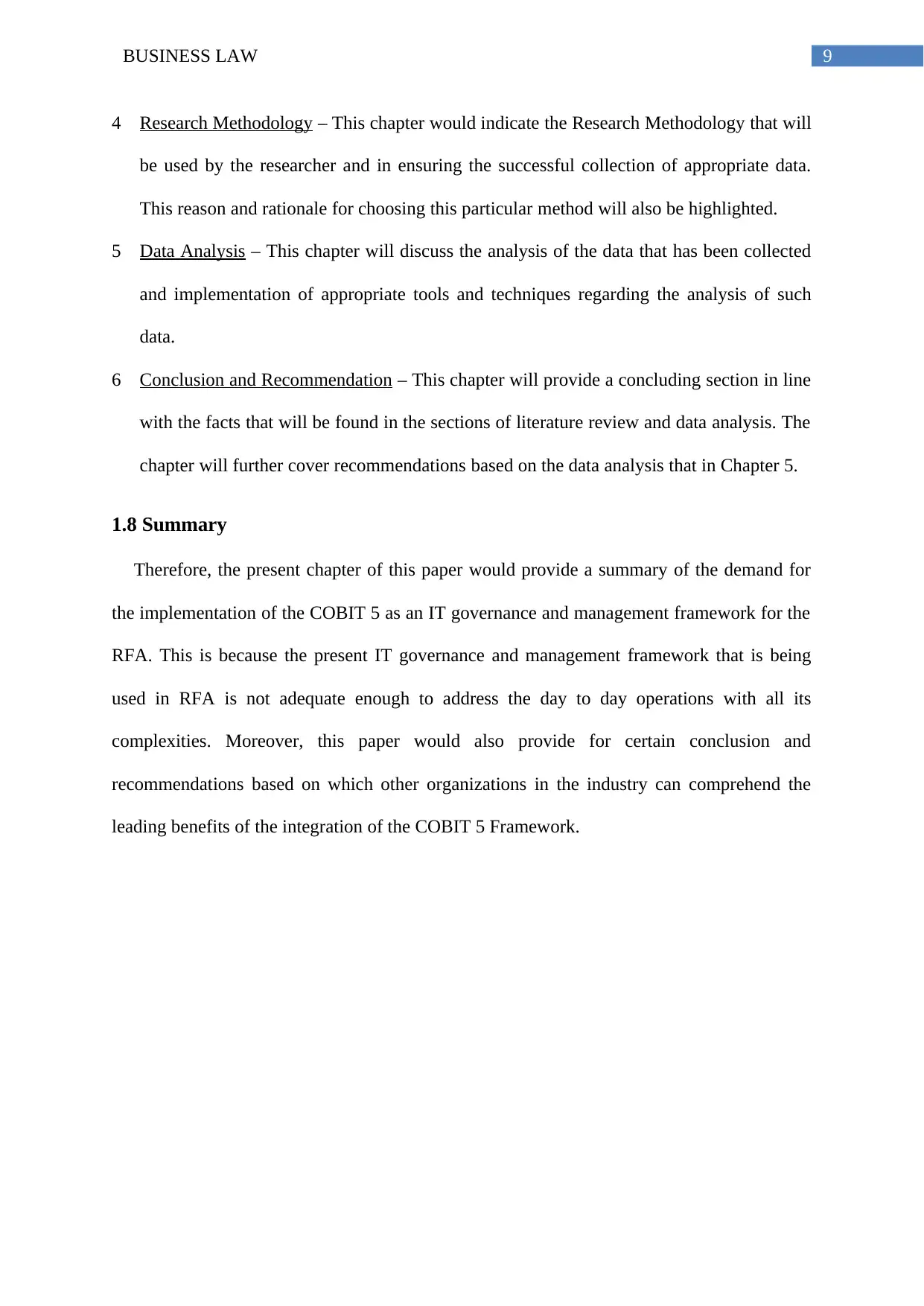
9BUSINESS LAW
4 Research Methodology – This chapter would indicate the Research Methodology that will
be used by the researcher and in ensuring the successful collection of appropriate data.
This reason and rationale for choosing this particular method will also be highlighted.
5 Data Analysis – This chapter will discuss the analysis of the data that has been collected
and implementation of appropriate tools and techniques regarding the analysis of such
data.
6 Conclusion and Recommendation – This chapter will provide a concluding section in line
with the facts that will be found in the sections of literature review and data analysis. The
chapter will further cover recommendations based on the data analysis that in Chapter 5.
1.8 Summary
Therefore, the present chapter of this paper would provide a summary of the demand for
the implementation of the COBIT 5 as an IT governance and management framework for the
RFA. This is because the present IT governance and management framework that is being
used in RFA is not adequate enough to address the day to day operations with all its
complexities. Moreover, this paper would also provide for certain conclusion and
recommendations based on which other organizations in the industry can comprehend the
leading benefits of the integration of the COBIT 5 Framework.
4 Research Methodology – This chapter would indicate the Research Methodology that will
be used by the researcher and in ensuring the successful collection of appropriate data.
This reason and rationale for choosing this particular method will also be highlighted.
5 Data Analysis – This chapter will discuss the analysis of the data that has been collected
and implementation of appropriate tools and techniques regarding the analysis of such
data.
6 Conclusion and Recommendation – This chapter will provide a concluding section in line
with the facts that will be found in the sections of literature review and data analysis. The
chapter will further cover recommendations based on the data analysis that in Chapter 5.
1.8 Summary
Therefore, the present chapter of this paper would provide a summary of the demand for
the implementation of the COBIT 5 as an IT governance and management framework for the
RFA. This is because the present IT governance and management framework that is being
used in RFA is not adequate enough to address the day to day operations with all its
complexities. Moreover, this paper would also provide for certain conclusion and
recommendations based on which other organizations in the industry can comprehend the
leading benefits of the integration of the COBIT 5 Framework.
Paraphrase This Document
Need a fresh take? Get an instant paraphrase of this document with our AI Paraphraser
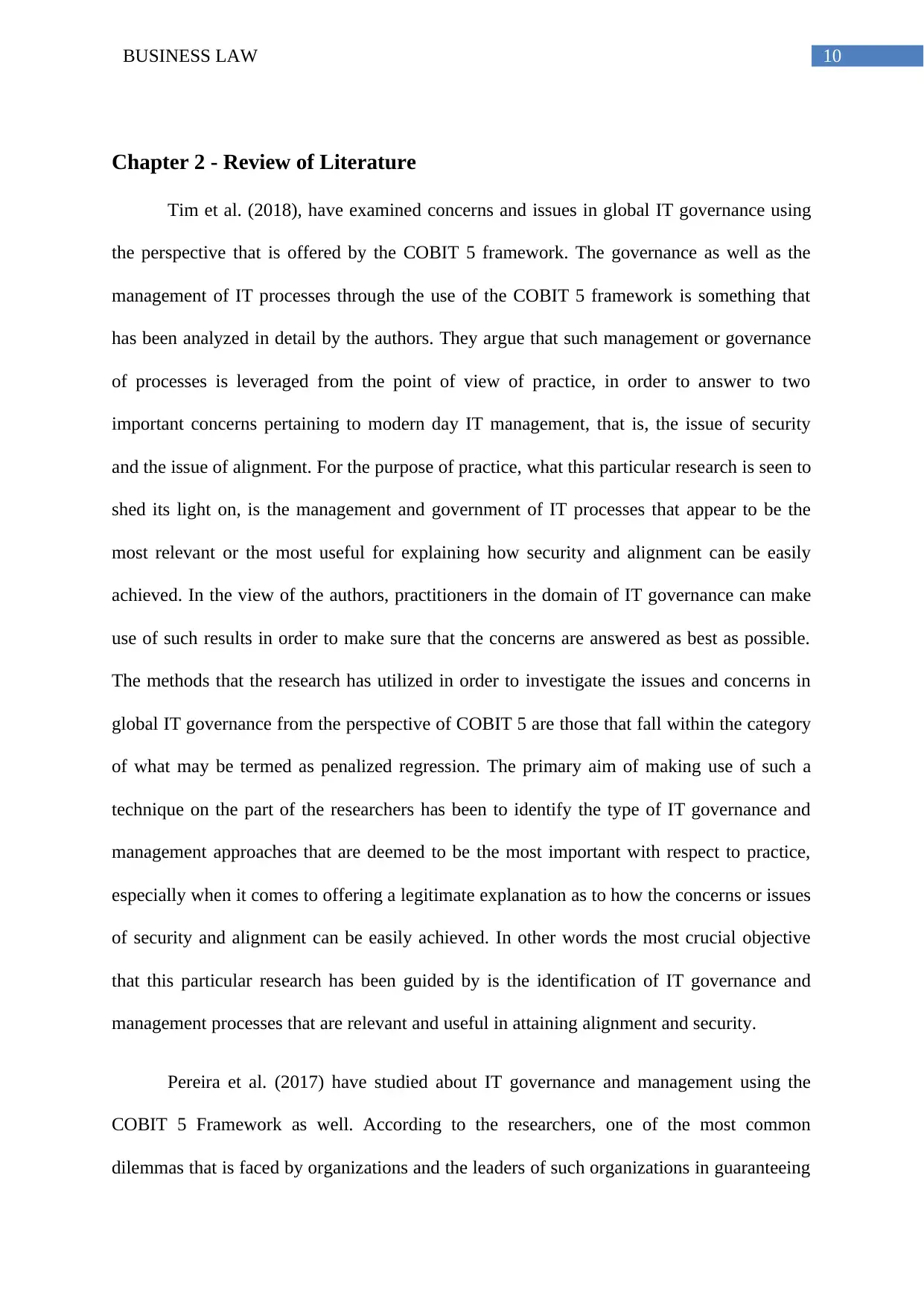
10BUSINESS LAW
Chapter 2 - Review of Literature
Tim et al. (2018), have examined concerns and issues in global IT governance using
the perspective that is offered by the COBIT 5 framework. The governance as well as the
management of IT processes through the use of the COBIT 5 framework is something that
has been analyzed in detail by the authors. They argue that such management or governance
of processes is leveraged from the point of view of practice, in order to answer to two
important concerns pertaining to modern day IT management, that is, the issue of security
and the issue of alignment. For the purpose of practice, what this particular research is seen to
shed its light on, is the management and government of IT processes that appear to be the
most relevant or the most useful for explaining how security and alignment can be easily
achieved. In the view of the authors, practitioners in the domain of IT governance can make
use of such results in order to make sure that the concerns are answered as best as possible.
The methods that the research has utilized in order to investigate the issues and concerns in
global IT governance from the perspective of COBIT 5 are those that fall within the category
of what may be termed as penalized regression. The primary aim of making use of such a
technique on the part of the researchers has been to identify the type of IT governance and
management approaches that are deemed to be the most important with respect to practice,
especially when it comes to offering a legitimate explanation as to how the concerns or issues
of security and alignment can be easily achieved. In other words the most crucial objective
that this particular research has been guided by is the identification of IT governance and
management processes that are relevant and useful in attaining alignment and security.
Pereira et al. (2017) have studied about IT governance and management using the
COBIT 5 Framework as well. According to the researchers, one of the most common
dilemmas that is faced by organizations and the leaders of such organizations in guaranteeing
Chapter 2 - Review of Literature
Tim et al. (2018), have examined concerns and issues in global IT governance using
the perspective that is offered by the COBIT 5 framework. The governance as well as the
management of IT processes through the use of the COBIT 5 framework is something that
has been analyzed in detail by the authors. They argue that such management or governance
of processes is leveraged from the point of view of practice, in order to answer to two
important concerns pertaining to modern day IT management, that is, the issue of security
and the issue of alignment. For the purpose of practice, what this particular research is seen to
shed its light on, is the management and government of IT processes that appear to be the
most relevant or the most useful for explaining how security and alignment can be easily
achieved. In the view of the authors, practitioners in the domain of IT governance can make
use of such results in order to make sure that the concerns are answered as best as possible.
The methods that the research has utilized in order to investigate the issues and concerns in
global IT governance from the perspective of COBIT 5 are those that fall within the category
of what may be termed as penalized regression. The primary aim of making use of such a
technique on the part of the researchers has been to identify the type of IT governance and
management approaches that are deemed to be the most important with respect to practice,
especially when it comes to offering a legitimate explanation as to how the concerns or issues
of security and alignment can be easily achieved. In other words the most crucial objective
that this particular research has been guided by is the identification of IT governance and
management processes that are relevant and useful in attaining alignment and security.
Pereira et al. (2017) have studied about IT governance and management using the
COBIT 5 Framework as well. According to the researchers, one of the most common
dilemmas that is faced by organizations and the leaders of such organizations in guaranteeing
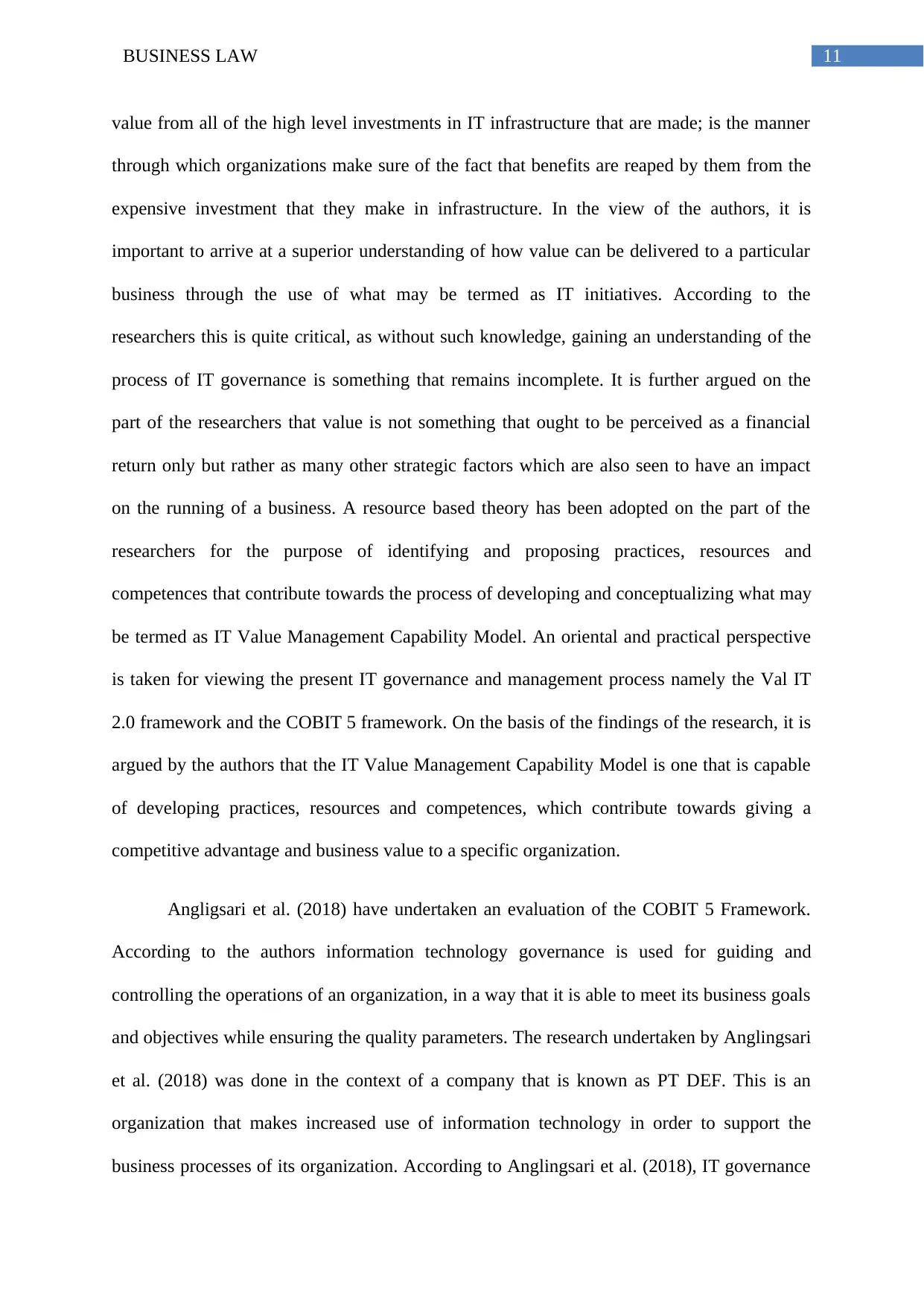
11BUSINESS LAW
value from all of the high level investments in IT infrastructure that are made; is the manner
through which organizations make sure of the fact that benefits are reaped by them from the
expensive investment that they make in infrastructure. In the view of the authors, it is
important to arrive at a superior understanding of how value can be delivered to a particular
business through the use of what may be termed as IT initiatives. According to the
researchers this is quite critical, as without such knowledge, gaining an understanding of the
process of IT governance is something that remains incomplete. It is further argued on the
part of the researchers that value is not something that ought to be perceived as a financial
return only but rather as many other strategic factors which are also seen to have an impact
on the running of a business. A resource based theory has been adopted on the part of the
researchers for the purpose of identifying and proposing practices, resources and
competences that contribute towards the process of developing and conceptualizing what may
be termed as IT Value Management Capability Model. An oriental and practical perspective
is taken for viewing the present IT governance and management process namely the Val IT
2.0 framework and the COBIT 5 framework. On the basis of the findings of the research, it is
argued by the authors that the IT Value Management Capability Model is one that is capable
of developing practices, resources and competences, which contribute towards giving a
competitive advantage and business value to a specific organization.
Angligsari et al. (2018) have undertaken an evaluation of the COBIT 5 Framework.
According to the authors information technology governance is used for guiding and
controlling the operations of an organization, in a way that it is able to meet its business goals
and objectives while ensuring the quality parameters. The research undertaken by Anglingsari
et al. (2018) was done in the context of a company that is known as PT DEF. This is an
organization that makes increased use of information technology in order to support the
business processes of its organization. According to Anglingsari et al. (2018), IT governance
value from all of the high level investments in IT infrastructure that are made; is the manner
through which organizations make sure of the fact that benefits are reaped by them from the
expensive investment that they make in infrastructure. In the view of the authors, it is
important to arrive at a superior understanding of how value can be delivered to a particular
business through the use of what may be termed as IT initiatives. According to the
researchers this is quite critical, as without such knowledge, gaining an understanding of the
process of IT governance is something that remains incomplete. It is further argued on the
part of the researchers that value is not something that ought to be perceived as a financial
return only but rather as many other strategic factors which are also seen to have an impact
on the running of a business. A resource based theory has been adopted on the part of the
researchers for the purpose of identifying and proposing practices, resources and
competences that contribute towards the process of developing and conceptualizing what may
be termed as IT Value Management Capability Model. An oriental and practical perspective
is taken for viewing the present IT governance and management process namely the Val IT
2.0 framework and the COBIT 5 framework. On the basis of the findings of the research, it is
argued by the authors that the IT Value Management Capability Model is one that is capable
of developing practices, resources and competences, which contribute towards giving a
competitive advantage and business value to a specific organization.
Angligsari et al. (2018) have undertaken an evaluation of the COBIT 5 Framework.
According to the authors information technology governance is used for guiding and
controlling the operations of an organization, in a way that it is able to meet its business goals
and objectives while ensuring the quality parameters. The research undertaken by Anglingsari
et al. (2018) was done in the context of a company that is known as PT DEF. This is an
organization that makes increased use of information technology in order to support the
business processes of its organization. According to Anglingsari et al. (2018), IT governance
⊘ This is a preview!⊘
Do you want full access?
Subscribe today to unlock all pages.

Trusted by 1+ million students worldwide
1 out of 48
Related Documents
Your All-in-One AI-Powered Toolkit for Academic Success.
+13062052269
info@desklib.com
Available 24*7 on WhatsApp / Email
![[object Object]](/_next/static/media/star-bottom.7253800d.svg)
Unlock your academic potential
Copyright © 2020–2025 A2Z Services. All Rights Reserved. Developed and managed by ZUCOL.





